
Slime mold or slime mould is an informal name given to several kinds of unrelated eukaryotic organisms that can live freely as single cells, but can aggregate together to form multicellular reproductive structures. Slime molds were formerly classified as fungi but are no longer considered part of that kingdom. Although not forming a single monophyletic clade, they are grouped within the paraphyletic group referred to as kingdom Protista.
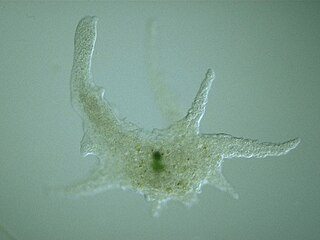
Amoebozoa is a major taxonomic group containing about 2,400 described species of amoeboid protists, often possessing blunt, fingerlike, lobose pseudopods and tubular mitochondrial cristae. In most classification schemes, Amoebozoa is ranked as a phylum within either the kingdom Protista or the kingdom Protozoa. In the classification favored by the International Society of Protistologists, it is retained as an unranked "supergroup" within Eukaryota. Molecular genetic analysis supports Amoebozoa as a monophyletic clade. Most phylogenetic trees identify it as the sister group to Opisthokonta, another major clade which contains both fungi and animals as well as some 300 species of unicellular protists. Amoebozoa and Opisthokonta are sometimes grouped together in a high-level taxon, variously named Unikonta, Amorphea or Opimoda.
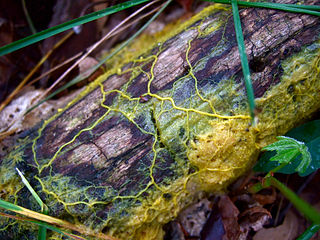
Physarum polycephalum, an acellular slime mold or myxomycete, is a protist with diverse cellular forms and broad geographic distribution. The “acellular” moniker derives from the plasmodial stage of the life cycle: the plasmodium is a bright yellow macroscopic multinucleate coenocyte shaped in a network of interlaced tubes. This stage of the life cycle, along with its preference for damp shady habitats, likely contributed to the original mischaracterization of the organism as a fungus. P. polycephalum is used as a model organism for research into motility, cellular differentiation, chemotaxis, cellular compatibility, and the cell cycle.

Lycogala epidendrum, commonly known as wolf's milk, groening's slime is a cosmopolitan species of myxogastrid amoeba which is often mistaken for a fungus. The aethalia, or fruiting bodies, occur either scattered or in groups on damp rotten wood, especially on large logs, from June to November. These aethalia are small, pink to brown cushion-like globs. They may excrete a pink paste if the outer wall is broken before maturity. When mature, the colour tends to become more brownish. When not fruiting, single celled individuals move about as very small, red amoeba-like organisms called plasmodia, masses of protoplasm that engulf bacteria, fungal and plant spores, protozoa, and particles of non-living organic matter through phagocytosis.

Fuligo septica is a species of plasmodial slime mold, and a member of the Myxomycetes class. It is commonly known as the scrambled egg slime, or flowers of tan because of its peculiar yellowish, bile-colored appearance. Also known as the dog vomit slime mold, it is common with a worldwide distribution, and it is often found on bark mulch in urban areas after heavy rain or excessive watering. Their spores are produced on or in aerial sporangia and are spread by wind.

Myxogastria/Myxogastrea or Myxomycetes (ICBN), is a class of slime molds that contains 5 orders, 14 families, 62 genera, and 888 species. They are colloquially known as the plasmodial or acellular slime moulds.

Calbovista is a fungal genus containing the single species Calbovista subsculpta, commonly known as the sculptured puffball, sculptured giant puffball, and warted giant puffball. It is a common puffball of the Rocky Mountains and Pacific Coast ranges of western North America. The puffball is more or less round with a diameter of up to 15 cm (6 in), white becoming brownish in age, and covered with shallow pyramid-shaped plates or scales. It fruits singly or in groups along roads and in open woods at high elevations, from summer to autumn.
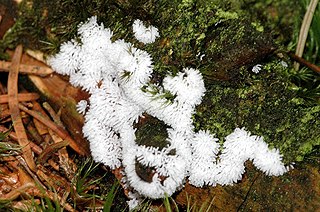
Ceratiomyxa is a genus of plasmodial slime mould within the Eumycetozoa, first described by Pier Antonio Micheli. They are widely distributed and commonly found on decaying wood.
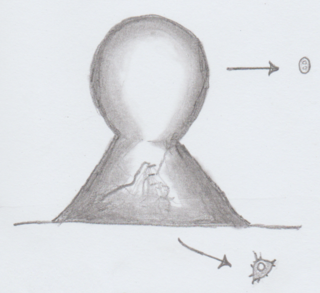
Fonticula is a genus of cellular slime mold which forms a fruiting body in a volcano shape. As long ago as 1979 it has been known to not have a close relationship with either the Dictyosteliida or the Acrasidae, the two well-established groups of cellular slime molds. In 1979, Fonticula was made a new genus of its own due to the unique characteristics of its fruiting body, with only one species: Fonticula alba.
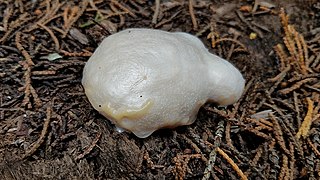
Enteridium lycoperdon, the false puffball, is one of the more obvious species of slime mould or Myxogastria, typically seen in its reproductive phase as a white 'swelling' on standing dead trees in the spring, or on large pieces of fallen wood. Alder is a common host.

Brefeldia maxima is a species of non-parasitic plasmodial slime mold, and a member of the class Myxomycetes. It is commonly known as the tapioca slime mold because of its peculiar pure white, tapioca pudding-like appearance. A common species with a worldwide distribution, particularly in North America and Europe. It is often found on bark after heavy rain or excessive watering. Their spores are produced on or in aerial sporangia and are spread by wind, however beetles of the family Lathridiidae are also reported to disperse the spores. Bonner states that soil invertebrates and rain mainly disperse spores as they are sticky and unlikely to be carried by air currents.

Protosteloid amoebae, also called protostelids, are amoebae that are capable of making simple fruiting bodies consisting of a cellular stalk topped by one or a few spores. All species are microscopic and are typically found on dead plant matter where they consume bacteria, yeasts, and fungal spores. Since protostelids are amoebae that make spores they are considered to be slime molds.

In true slime molds, the myxogastria, the hypothallus is the layer on which the fruit body sits, lying in contact with the substrate. Roughly translated, it means "under the thallus".

Trichia decipiens is a worldwide widespread slime mould species from the order Trichiida.
Prototrichia metallica is a slime mould species from the order Trichiida and the only species from the genus Prototrichia. It is mainly distributed on mountains.
Physarum aeneum is a slime mould species from the order Physarida. It is one of a few slime moulds mainly common in the tropics and subtropics.
Listerella paradoxa is a slime mould species from the class Myxogastria and the only member of its genus as well as the family Listerelliidae. The species is so far only found on the wattle genus Cladonia, mostly in European temperate zones.

Lindbladia tubulina is a slime mould species from the order Liceida and the only member of its genus.
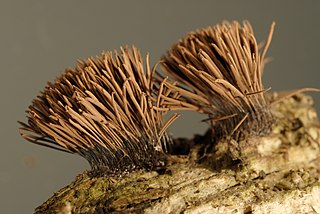
Stemonitis axifera is a species of slime mold. It fruits in clusters on dead wood, and has distinctive tall reddish-brown sporangia, supported on slender stalks.

Hemitricha is a genus of slime molds, of the family Trichiidae, found within the order Trichiida. It was first described by Josef Rostafinksi in 1873 and remains a well-defined genus of the slime molds. Hemitrichia species exhibit either plasmodiocarp or sporangium fruiting bodies, both of which are well-known and recognizable slime molds seen on multiple continents. The genus includes Hemtrichia serpula, known as the pretzel slime mold, an iconic and widespread species that has been used to examine speciation in slime molds.

















